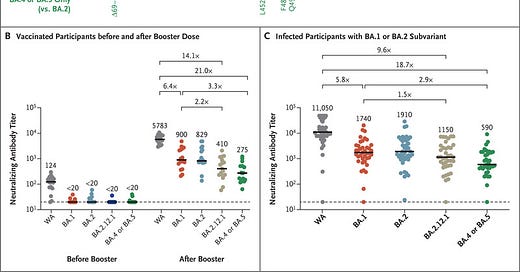The letter to the NEJM ‘Neutralization Escape by SARS-CoV-2 Omicron Subvariants BA.2.12.1, BA.4, and BA.5’ is comparing
27 vaccinated people, before and after booster, with no ‘covid’ symptoms and negative PCR with
27 vaccinated people (apart from one unvaccinated), with mild symptoms plus one asymptomatic, with a positive PCR.
They are only comparing vaccinated with vaccinated. There can be no talk of natural immunity nor anything else. The one unvaccinated case, who had severe symptoms, had no antibodies and therefore apparently no immunity.
The alleged variants are in fact cell cultures made using samples chosen from different patients with apparently diminishing severity of symptoms and thus will containing different amounts of proteins made by cells under stress. The PCR detects the RNA thought to code for some chosen stress proteins, such as the ‘spike’ p180.
The booster, if indeed the mRNA is translated into the stress protein p180, will cause the body to produce antibodies that react to it. Or stress proteins may be produced by the trauma of the toxins and vaccination itself with subsequent antibody production. No controls are done of vaccination without mRNA. The antibody titre presumably then drops back to pre-booster levels after a couple of months.
The 27 vaccinated (B) in whom the chosen culture proteins were not detected (PCR-ve)(they were excluded if testing positive) would not be expected to have many antibodies in their serum that react to them.
The 26 vaccinated (C) in whom the chosen culture proteins were detected (PCR+ve) will be expected to have antibodies in their serum that react to them.
The antibody titres in B and C diminish with the different ‘strains’ not because a virus has mutated and the antibodies no longer recognise antigens on them but because the chosen cell cultures used are made from different people with diminishing severity of symptoms and will contain different amounts of stress proteins for the antibodies to bind to.
Days from positive PCR until sampling ranged from 2-113, with a median of 29. According to Enders and Peebles in 1954 (2), and many subsequent studies, antibody titre increases up to 30 fold from the acute phase to the convalescing phase of an illness/detoxification. In the study; the unvaccinated person with severe symptoms was sampled in the acute phase, only 4 days after testing positive, explaining why they had no detectable antibodies, while most of the rest, sampled a median of 29 days after testing positive were in the convalescing phase, explaining why they had plenty of antibodies. This proliferation of antibodies in the convalescent phase implies that antibodies have nothing to do with fighting an infection and have some other role to play in homeostasis.
The vaccinated in B did not have a period of illness/detoxification, it is not expected that they will antibodies with proliferate to play a role in convalescence; an explanation as to why less antibodies were detected in B, even with artificially making the body produced some stress proteins, than in C.
Nothing can be inferred about the likelihood of future illness from this experiment.
Jo
1)https://www.nejm.org/doi/full/10.1056/NEJMc22065761)https://pubmed.ncbi.nlm.nih.gov/13403020/
2)Measles virus: a summary of experiments concerned with isolation, properties, and behavior
J F ENDERS, T C PEEBLES, K MCCARTHY, M MILOVANOVIC, A MITUS, A HOLLOWAY




